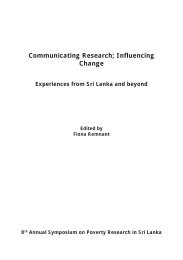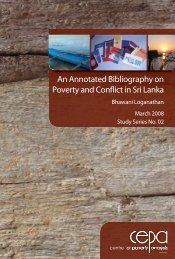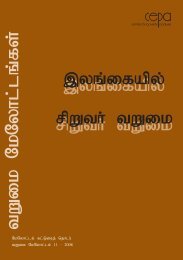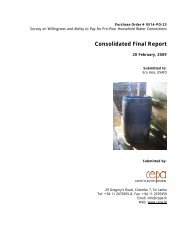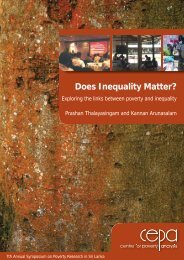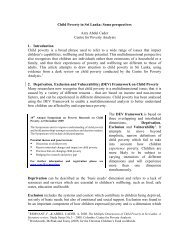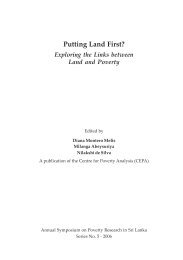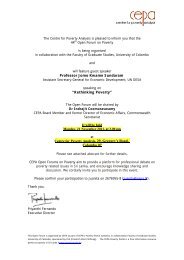Involuntary Displacement and Resettlement â Policy and ... - CEPA
Involuntary Displacement and Resettlement â Policy and ... - CEPA
Involuntary Displacement and Resettlement â Policy and ... - CEPA
- No tags were found...
Create successful ePaper yourself
Turn your PDF publications into a flip-book with our unique Google optimized e-Paper software.
<strong>CEPA</strong>’s work on monitoring resettlement activity of the Southern TransportDevelopment Project provides some insights on how vulnerability is dealtwith. The institutional framework for dealing with resettlement has thecapacity to address vulnerabilities that have been identified as existing priorto l<strong>and</strong> acquisition, through payment of special allowances <strong>and</strong> the provisionof non-monetary support. It has less space to address the vulnerabilitiescreated by the project. The project focuses on physical displacement <strong>and</strong>those who are categorised as ‘affected’ have typically lost houses or l<strong>and</strong>, orhave been subject to construction related impacts. The institutional m<strong>and</strong>ate<strong>and</strong> capacity to deal effectively with the vulnerability of those people whowere not physically ‘affected’ but who lost their livelihoods or who areaffected by the loss of common property (i.e. water sources) for example orchanges to the environment (e.g. flooding due to blockage of local irrigationworks) were much weaker when compared with the focus on ‘affectedpersons’.In the STDP, different vulnerabilities (women, the elderly, <strong>and</strong> the disabled)were identified <strong>and</strong> the tendency to homogenise vulnerability through theprovision of a single allowance was avoided by working on a case by casebasis. On the other h<strong>and</strong>, narrow categorisation (e.g. limiting the analysis ofgender issues solely to female headed households), has precluded dealingwith other groups of vulnerable people such as women engaged in homebased livelihoods. The ‘affected people’ have been able to reduce theirvulnerability by using their compensation <strong>and</strong> other support received toincrease their financial <strong>and</strong> fixed asset base, make good investments <strong>and</strong>strengthen their networks. Vulnerability increased when people lost thestability of their income sources, when networks broke up, <strong>and</strong> there wereproblems of illness to cope with, in addition to the trauma of resettlement.Vulnerability can be discussed from different perspectives, <strong>and</strong> the abovediscussion is far from exhaustive. However, it highlights some importantissues such as:The value <strong>and</strong> the dangers of categorisation, <strong>and</strong> the need toexamine the categories in the international discourse.• The importance of considering the relationships between thedisplaced persons <strong>and</strong> their host communities. Humanitarian <strong>and</strong>development agencies need to recognise that categorisation ofIDPs or ‘affected persons’ usually excludes dealing with vulnerabilityin the host communities <strong>and</strong> could thus result in tensions.8



